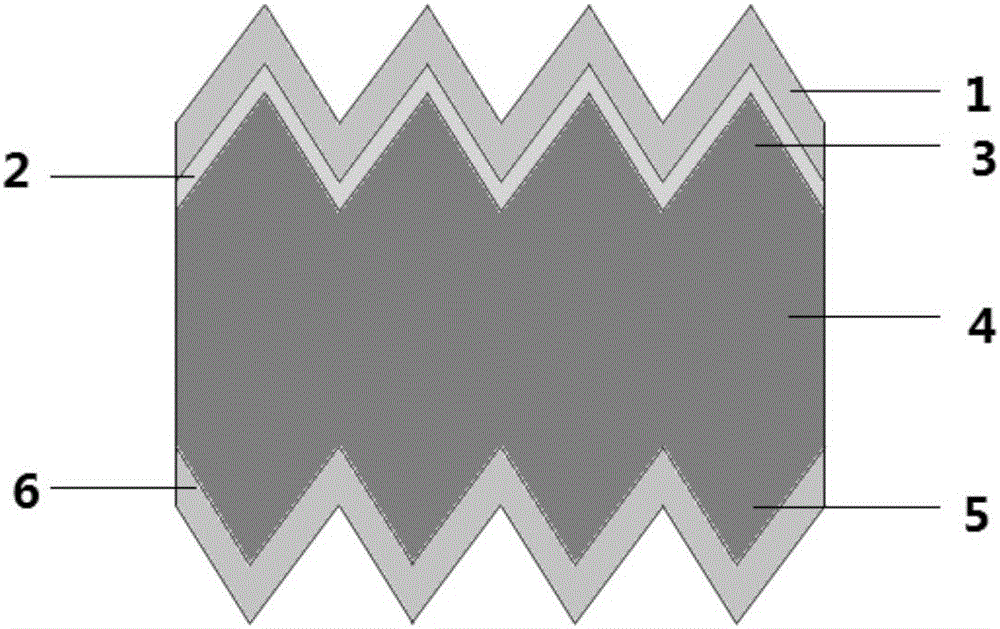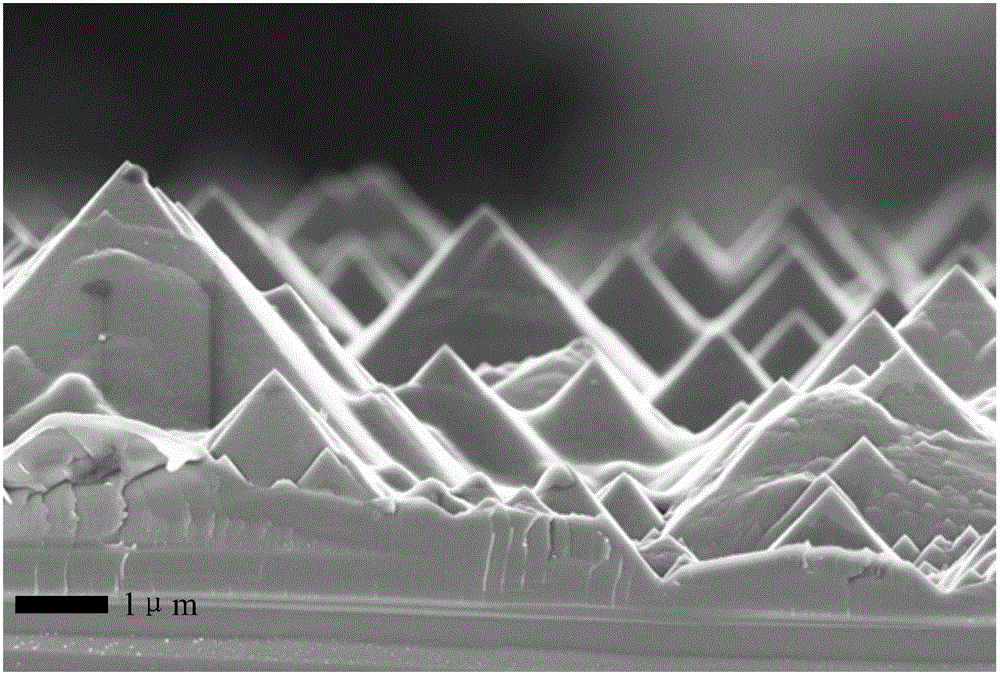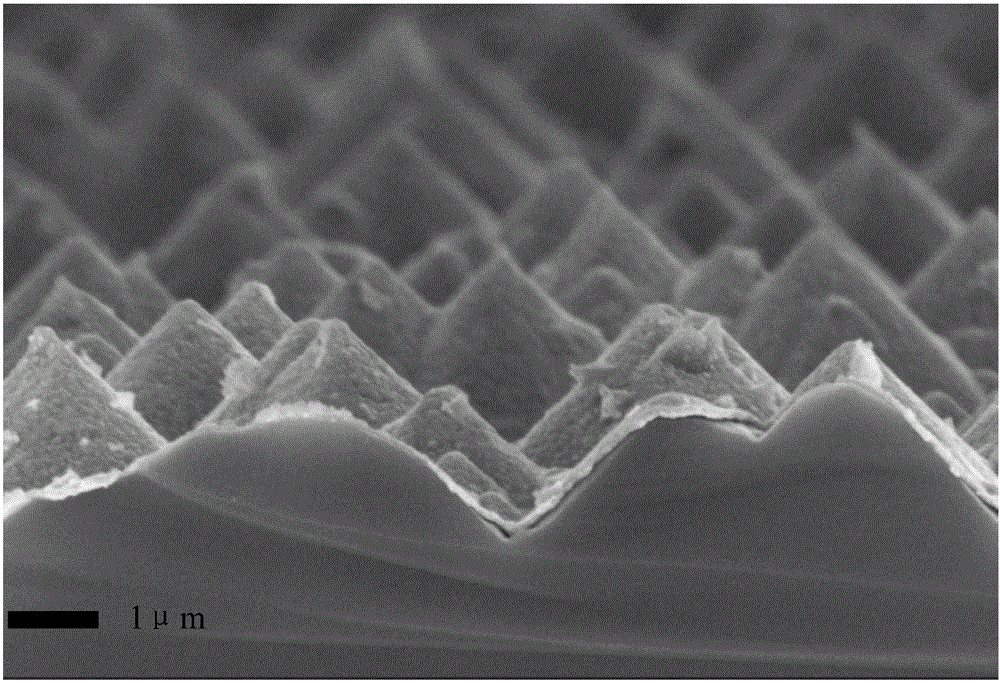Transition metallic oxide-silicon heterojunction solar cell and preparation method thereof
A solar cell, transition metal technology, applied in circuits, photovoltaic power generation, electrical components, etc., to achieve the effect of improving separation and transmission efficiency, enhancing stability, and improving absorption
- Summary
- Abstract
- Description
- Claims
- Application Information
AI Technical Summary
Problems solved by technology
Method used
Image
Examples
Embodiment 1
[0041] Prepare a transition metal oxide-silicon heterojunction solar cell according to the following steps:
[0042] (1) Use commercialized double-sided polishing, N-type monocrystalline silicon wafers with a resistivity of 1-10 ohms per centimeter and a crystal orientation of 100; clean the silicon wafers with RCA standard cleaning method, and then dry them with nitrogen. Obtain an N-type silicon substrate;
[0043] Put the N-type silicon substrate into a mixed aqueous solution with a mass fraction of 2% NaOH and a mass fraction of 10% absolute ethanol, etch at 80°C for 30 minutes; then take it out and soak it in dilute hydrochloric acid for 10 minutes to remove the residual Alkaline solution, then rinse with deionized water to obtain an N-type silicon substrate with a silicon pyramid array on the upper surface and an inverted silicon pyramid array on the lower surface; the scanning electron microscope of the silicon pyramid array is as follows figure 2 shown, from figure...
Embodiment 2
[0050] Prepare a transition metal oxide-silicon heterojunction solar cell according to the following steps:
[0051] (1) Use commercialized double-sided polishing, N-type monocrystalline silicon wafers with a resistivity of 1-10 ohms per centimeter and a crystal orientation of 100; clean the silicon wafers with RCA standard cleaning method, and then dry them with nitrogen. Obtain an N-type silicon substrate;
[0052] Put the cleaned silicon chip into a mixed aqueous solution of 2% NaOH and 10% absolute ethanol, etch at 80°C for 30 minutes; then take it out and soak it in dilute hydrochloric acid for 10 minutes to remove The residual alkali solution is rinsed with deionized water to obtain an N-type silicon substrate with a silicon pyramid array on the upper surface and an inverted silicon pyramid array on the lower surface; as can be seen from the scanning electron microscope diagram of the silicon pyramid array, The silicon pyramid array grown with anisotropy has a good arra...
Embodiment 3
[0058] Prepare a transition metal oxide-silicon heterojunction solar cell according to the following steps:
[0059] (1) Use commercialized double-sided polishing, N-type monocrystalline silicon wafers with a resistivity of 1-10 ohms per centimeter and a crystal orientation of 100; clean the silicon wafers with RCA standard cleaning method, and then dry them with nitrogen. Obtain an N-type silicon substrate;
[0060] Put the cleaned silicon chip into a mixed aqueous solution of 2% NaOH and 10% absolute ethanol, etch at 80°C for 30 minutes; then take it out and soak it in dilute hydrochloric acid for 10 minutes to remove The residual alkali solution is rinsed with deionized water to obtain an N-type silicon substrate with a silicon pyramid array on the upper surface and an inverted silicon pyramid array on the lower surface; as can be seen from the scanning electron microscope diagram of the silicon pyramid array, The silicon pyramid array grown with anisotropy has a good arra...
PUM
| Property | Measurement | Unit |
|---|---|---|
| Thickness | aaaaa | aaaaa |
| Short circuit current density | aaaaa | aaaaa |
| Open circuit voltage | aaaaa | aaaaa |
Abstract
Description
Claims
Application Information
 Login to View More
Login to View More - R&D
- Intellectual Property
- Life Sciences
- Materials
- Tech Scout
- Unparalleled Data Quality
- Higher Quality Content
- 60% Fewer Hallucinations
Browse by: Latest US Patents, China's latest patents, Technical Efficacy Thesaurus, Application Domain, Technology Topic, Popular Technical Reports.
© 2025 PatSnap. All rights reserved.Legal|Privacy policy|Modern Slavery Act Transparency Statement|Sitemap|About US| Contact US: help@patsnap.com



